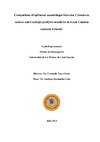Identificador persistente para citar o vincular este elemento:
https://accedacris.ulpgc.es/handle/10553/10578
| DC Field | Value | Language |
|---|---|---|
| dc.contributor.advisor | Tuya, F. | - |
| dc.contributor.advisor | Hernández-León, Santiago | - |
| dc.contributor.author | Png González, Lydia | - |
| dc.date.accessioned | 2013-07-26T09:27:21Z | - |
| dc.date.accessioned | 2018-05-15T10:47:22Z | - |
| dc.date.available | 2013-07-26T09:27:21Z | - |
| dc.date.available | 2018-05-15T10:47:22Z | - |
| dc.date.issued | 2013 | en_US |
| dc.identifier.other | Gestión académica | - |
| dc.identifier.uri | https://accedacris.ulpgc.es/handle/10553/10578 | - |
| dc.description.abstract | Epifaunal invertebrates are sensitive to changes in the identity of the dominant host plant, so assessing differences in the diversity, abundance and structure of epifaunal assemblages is particularly pertinent in areas where seagrasses have been replaced by alternative vegetation (e.g. green seaweeds). In this study, we aimed to compare the diversity, abundance and structure of epifaunal assemblages, with particular emphasis on amphipods, between meadows dominated by Cymodocea nodosa and the green algae Caulerpa prolifera on shallow soft bottoms of Gran Canaria Island, determining whether patterns were temporally consistent. The epifaunal assemblage structure (abundance and composition) consistently differed between both plants, being more diverse and abundant epifaunal assemblages associated with C. prolifera-dominated beds than those inhabiting C. nodosa meadows. Amphipods constituted ca. 70% of crustaceans for the overall study, including 37 species belonging to 16 families. The amphipods abundance recorded was ca. 3 times larger in C. prolifera-dominated beds (1248.13 ± 136.83 ind. m-2, mean ± SE) than in C. nodosa meadows (396.88 ± 77.36 ind. m-2). Multivariate analysis of the community showed significant differences between habitats, with a clear segregation of the species. For instance, Microdeutopus stationis, Dexamine spinosa, Aora spinicornis, Ischyrocerus inexpectatus and Apherusa bispinosa were more abundant in C. prolifera-dominated beds; while the new genus, new species of caprellid, Mantacaprella macaronensis, dominated in C. nodosa meadows. However, some species such as Pseudoprotella phasma and Ampithoe ramondi were found without significant differences in both habitats. | en_US |
| dc.language | eng | en_US |
| dc.relation | Changes In Submersed Vegetation:Assessing Loss In Ecosystems Services From Frondose To Depauperate Systems Dominated By Oppotunistic Vegetation | en_US |
| dc.subject | 251001 Oceanografía biológica | en_US |
| dc.subject | 251005 Zoología marina | en_US |
| dc.subject.other | Amphipoda | en_US |
| dc.subject.other | Epifauna | en_US |
| dc.subject.other | Seagrass | en_US |
| dc.subject.other | Ecosystem services | en_US |
| dc.subject.other | Assemblage structure | en_US |
| dc.title | Comparison of epifaunal assemblages between Cymodocea nodosa and Caulerpa prolifera meadows in Gran Canaria (eastern Atlantic) | en_US |
| dc.type | info:eu-repo/semantics/masterThesis | en_US |
| dc.type | MasterThesis | en_US |
| dc.compliance.driver | 1 | - |
| dc.contributor.departamento | Biología | en_US |
| dc.contributor.facultad | Facultad de Ciencias del Mar | en_US |
| dc.identifier.crisid | - | - |
| dc.investigacion | Ciencias | en_US |
| dc.rights.accessrights | info:eu-repo/semantics/openAccess | - |
| dc.type2 | Trabajo final de máster | en_US |
| dc.description.notas | Máster en Oceanografía ; 2013 | en_US |
| dc.utils.revision | Sí | en_US |
| dc.identifier.matricula | TFT-27797 | - |
| dc.identifier.ulpgc | Sí | en_US |
| dc.contributor.buulpgc | BU-BAS | en_US |
| dc.contributor.titulacion | Máster Universitario en Oceanografía | - |
| item.fulltext | Con texto completo | - |
| item.grantfulltext | open | - |
| crisitem.advisor.dept | GIR ECOAQUA: Biodiversidad y Conservación | - |
| crisitem.advisor.dept | IU de Investigación en Acuicultura Sostenible y Ec | - |
| crisitem.advisor.dept | Departamento de Biología | - |
| crisitem.advisor.dept | GIR IOCAG: Oceanografía Biológica y Cambio Global | - |
| crisitem.advisor.dept | IU de Oceanografía y Cambio Global | - |
| crisitem.advisor.dept | Departamento de Biología | - |
| crisitem.project.principalinvestigator | Tuya Cortés, Fernando José | - |
| Appears in Collections: | Trabajo final de máster | |
Page view(s)
138
checked on Nov 1, 2024
Download(s)
180
checked on Nov 1, 2024
Google ScholarTM
Check
Share
Export metadata
This item is licensed under a Creative Commons License

